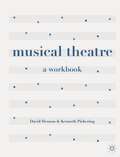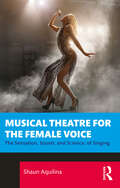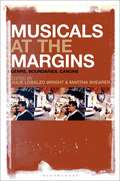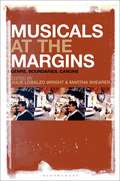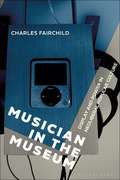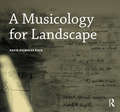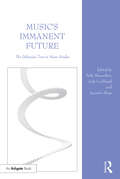- Table View
- List View
Musical Theatre: A Workbook
by Kenneth Pickering David HensonDrawing on the history and development of Musical Theatre, this engaging workbook provides a comprehensive overview of the nuts and bolts of the discipline. Introducing students to the basics of the theory and history of musical theatre, it covers all four elements of any Musical Theatre course: dance, music, acting and performing. Acting as a guide through the entire process of preparing material for performance, this essential companion presents a number of stimulating exercises, questions, activities and topics for discussion to aid personal and professional development. This clear, comprehensive workbook is an ideal core text for Musical Theatre students of all levels. Packed with help, ideas and guidance for teaching, it will also appeal to directors and instructors.
Musical Theatre Auditions and Casting: A performer's guide viewed from both sides of the audition table
by Neil RutherfordMusical theatre is a tough and over-crowded industry. Yet, despite the huge competition, many performers find auditioning difficult with little knowledge of what the directors, creative teams and producers are looking for, or how to win the panel over with their unique talent. As a leading international casting director, Neil Rutherford has seen thousands of hopefuls audition over the years. Uniquely, he also understands what it is like to audition from his years as a professional actor in musical theatre.This book provides a unique perspective on the musical theatre audition process and how to improve the chances of landing a role. With wit, humour and insight, Neil Rutherford guides the reader through the crucial elements of musical theatre auditions, opening up the process of casting and auditioning to the thousands of hopefuls trying to secure work in this industry every year, as well as anyone involved in musical theatre. With a foreword by Tony-award-winning director Bartlett Sher, the book also contains contributions from some of the world's leading directors and musical directors, including Sir Richard Eyre and Jerry Mitchell, adding further valuable insight from those at the centre of the musical theatre world. This book is a vital tool for anyone hoping to improve their audition chances and survive in the world of musical theatre.
Musical Theatre Auditions and Casting: A performer's guide viewed from both sides of the audition table
by Neil RutherfordMusical theatre is a tough and over-crowded industry. Yet, despite the huge competition, many performers find auditioning difficult with little knowledge of what the directors, creative teams and producers are looking for, or how to win the panel over with their unique talent. As a leading international casting director, Neil Rutherford has seen thousands of hopefuls audition over the years. Uniquely, he also understands what it is like to audition from his years as a professional actor in musical theatre.This book provides a unique perspective on the musical theatre audition process and how to improve the chances of landing a role. With wit, humour and insight, Neil Rutherford guides the reader through the crucial elements of musical theatre auditions, opening up the process of casting and auditioning to the thousands of hopefuls trying to secure work in this industry every year, as well as anyone involved in musical theatre. With a foreword by Tony-award-winning director Bartlett Sher, the book also contains contributions from some of the world's leading directors and musical directors, including Sir Richard Eyre and Jerry Mitchell, adding further valuable insight from those at the centre of the musical theatre world. This book is a vital tool for anyone hoping to improve their audition chances and survive in the world of musical theatre.
The Musical Theatre Composer as Dramatist: A Handbook for Collaboration
by Rebecca Applin WarnerDramaturgy is at the heart of any musical theatre score, proving that song and music combined can collectively act as drama. The Musical Theatre Composer as Dramatist: A Handbook for Collaboration offers techniques for approaching a musical with the drama at the centre of the music. Written by a working composer of British musical theatre, this original and highly practical book is intended for composers, students of musical theatre and performing arts and their collaborators. Through detailed case studies, conceptual frameworks and frank analysis, this book encourages the collaboration between the languages of music and drama. It offers a shared language for talking about music in the creation of musical theatre, as well as practical exercises for both composers and their collaborators and ways of analysing existing musical theatre scores for those who are versed in musical terminology, and those who are not.Speaking directly to the contemporary artist, working examples are drawn from a wide range of musicals throughout Part One, before a full case study analysis of Matilda the Musical brings all the ideas together in Part Two. Part Three offers a range of practical exercises for anyone creating new musicals, particularly composers and their collaborators.
The Musical Theatre Composer as Dramatist: A Handbook for Collaboration
by Rebecca Applin WarnerDramaturgy is at the heart of any musical theatre score, proving that song and music combined can collectively act as drama. The Musical Theatre Composer as Dramatist: A Handbook for Collaboration offers techniques for approaching a musical with the drama at the centre of the music. Written by a working composer of British musical theatre, this original and highly practical book is intended for composers, students of musical theatre and performing arts and their collaborators. Through detailed case studies, conceptual frameworks and frank analysis, this book encourages the collaboration between the languages of music and drama. It offers a shared language for talking about music in the creation of musical theatre, as well as practical exercises for both composers and their collaborators and ways of analysing existing musical theatre scores for those who are versed in musical terminology, and those who are not.Speaking directly to the contemporary artist, working examples are drawn from a wide range of musicals throughout Part One, before a full case study analysis of Matilda the Musical brings all the ideas together in Part Two. Part Three offers a range of practical exercises for anyone creating new musicals, particularly composers and their collaborators.
Musical Theatre For Dummies
by Seth RudetskyDiscover what goes on behind the curtains of your favorite musical Have you ever dreamed of being in a Broadway musical, or even just to be in the ensemble in your local community theatre? In Musical Theater For Dummies, Broadway insider and host of Sirus/XM Radio’s ON BROADWAY channel Seth Rudetsky takes you backstage and shows you what it takes to create a spectacular production. You’ll get the behind-the-curtain view of how your favorite on- and off-Broadway shows are made, plus get expert advice on how to launch your own career under the bright lights. If you’re new to musical theater, this book will initiate you into the world of musicals by sharing the stories and lingo that defines this fascinating world. This unique book shares insights into what makes musical theatre tick and how you can enjoy a show from your seat in the audience or from the stage itself. Learn the history of musical theater and discover the shows born on Broadway or the West End that became cultural phenomena Trace the development of productions, from the idea stage all the way through opening night and beyond Enjoy theater productions more, thanks to deep insights into how theater is made Get insider advice on the skills you need to perform in professional or amateur musical theater productions Real-life anecdotes and excellent show recommendations will entertain and delight you as you become a musical theater know-it-all, with Dummies.
Musical Theatre For Dummies
by Seth RudetskyDiscover what goes on behind the curtains of your favorite musical Have you ever dreamed of being in a Broadway musical, or even just to be in the ensemble in your local community theatre? In Musical Theater For Dummies, Broadway insider and host of Sirus/XM Radio’s ON BROADWAY channel Seth Rudetsky takes you backstage and shows you what it takes to create a spectacular production. You’ll get the behind-the-curtain view of how your favorite on- and off-Broadway shows are made, plus get expert advice on how to launch your own career under the bright lights. If you’re new to musical theater, this book will initiate you into the world of musicals by sharing the stories and lingo that defines this fascinating world. This unique book shares insights into what makes musical theatre tick and how you can enjoy a show from your seat in the audience or from the stage itself. Learn the history of musical theater and discover the shows born on Broadway or the West End that became cultural phenomena Trace the development of productions, from the idea stage all the way through opening night and beyond Enjoy theater productions more, thanks to deep insights into how theater is made Get insider advice on the skills you need to perform in professional or amateur musical theater productions Real-life anecdotes and excellent show recommendations will entertain and delight you as you become a musical theater know-it-all, with Dummies.
Musical Theatre for the Female Voice: The Sensation, Sound, and Science, of Singing
by Shaun AquilinaFemale musical theatre singers produce some of the most exciting and expressive singing an audience can experience. They also face a unique and specific set of issues when approaching their craft, from negotiating the registers of their voice to enable them to belt, to vocal health challenges such as premenstrual voice syndrome. This is the only book that offers a full and detailed guide to tackling those issues and to singing with full expression and technical excellence. Musical Theatre for the Female Voice covers the origin of singing in musicals, from the bel canto style of 300 years ago through to the latest developments in high belting, in shows such as Wicked and Waitress. It offers the reader exercises and methods that have been used to train hundreds of singers at some of the UK’s leading musical theatre training institutions and are underpinned by the latest academic research in journals on singing, psychology, and health. Every element of a singer's toolkit is covered from a female perspective, from breath and posture to character work and vocal health. This is an essential guidebook for female singers in musical theatre productions, either training at university or conservatory level or forging a career as professional triple-threat performers.
Musical Theatre for the Female Voice: The Sensation, Sound, and Science, of Singing
by Shaun AquilinaFemale musical theatre singers produce some of the most exciting and expressive singing an audience can experience. They also face a unique and specific set of issues when approaching their craft, from negotiating the registers of their voice to enable them to belt, to vocal health challenges such as premenstrual voice syndrome. This is the only book that offers a full and detailed guide to tackling those issues and to singing with full expression and technical excellence. Musical Theatre for the Female Voice covers the origin of singing in musicals, from the bel canto style of 300 years ago through to the latest developments in high belting, in shows such as Wicked and Waitress. It offers the reader exercises and methods that have been used to train hundreds of singers at some of the UK’s leading musical theatre training institutions and are underpinned by the latest academic research in journals on singing, psychology, and health. Every element of a singer's toolkit is covered from a female perspective, from breath and posture to character work and vocal health. This is an essential guidebook for female singers in musical theatre productions, either training at university or conservatory level or forging a career as professional triple-threat performers.
Musical Theatre Histories: Expanding the Narrative
by Millie Taylor Adam RushMusical theatre is often perceived as either a Broadway based art form, or as having separate histories in London and New York. Musical Theatre Histories: Expanding the Narrative, however, depicts the musical as neither American nor British, but both and more, having grown out of frequent and substantial interactions between both centres (and beyond). Through multiple thematic 'histories', Millie Taylor and Adam Rush take readers on a series of journeys that include the art form's European and American origins, African American influences, negotiations arounddiversity, national identity, and the globalisation of the form, as well as revival culture, censorship and the place of social media inthe 21st century.Each chapter includes case studies and key concept boxes to identify, explain and contextualise important discussions, offering an accessible study of a dynamic and ever evolving medium.Written and developed for undergraduate students, this introductory textbook provides a newly focused and alternative way of understanding musical theatre history.
Musical Theatre Histories: Expanding the Narrative
by Millie Taylor Adam RushMusical theatre is often perceived as either a Broadway based art form, or as having separate histories in London and New York. Musical Theatre Histories: Expanding the Narrative, however, depicts the musical as neither American nor British, but both and more, having grown out of frequent and substantial interactions between both centres (and beyond). Through multiple thematic 'histories', Millie Taylor and Adam Rush take readers on a series of journeys that include the art form's European and American origins, African American influences, negotiations arounddiversity, national identity, and the globalisation of the form, as well as revival culture, censorship and the place of social media inthe 21st century.Each chapter includes case studies and key concept boxes to identify, explain and contextualise important discussions, offering an accessible study of a dynamic and ever evolving medium.Written and developed for undergraduate students, this introductory textbook provides a newly focused and alternative way of understanding musical theatre history.
Musical Theatre Script and Song Analysis Through the Ages
by James OlmHow many times have you experienced a musical that was fabulous or just didn't work at all, but you had no idea how to communicate why? How do you differentiate between a flaw in the performance portrayal of a character to a structural flaw in the musical itself? How do you analyse musical theatre songs that are so subjective in its very nature? Is there even a common link of analysis between musicals from the Golden Age and musicals from the present day? Musical Theatre Script and Song Analysis Through the Ages answers these questions and gives students of musical theatre the tools they need to understand and articulate how musicals work. At the heart of any musical lie its music and lyrics, yet it is this area that is least understood. This book offers a brand new terminology of analysis that gets to the core of what holds a musical together: the libretto, music, and lyrics. Through identifying methods of lyric and musical analysis and applying these to ten different musicals throughout history, students are able to ask questions such as: why does this song sound this way?; what is this lyric doing to identify character purpose?; and how is a character communicating this feeling to an audience?From classroom analysis through to practical application, this text guides readers through a structured approach to understanding, disseminating and more importantly, articulating how a musical works. A perfect tool for students of musical theatre, its practical benefits of understanding the form, and realizing that it can be applied to any age musical, will benefit any theatre person in helping articulate all of those abstract feelings that are inherent in this art form. It offers a roadmap to the musical's innermost DNA.
Musical Theatre Script and Song Analysis Through the Ages
by James OlmHow many times have you experienced a musical that was fabulous or just didn't work at all, but you had no idea how to communicate why? How do you differentiate between a flaw in the performance portrayal of a character to a structural flaw in the musical itself? How do you analyse musical theatre songs that are so subjective in its very nature? Is there even a common link of analysis between musicals from the Golden Age and musicals from the present day? Musical Theatre Script and Song Analysis Through the Ages answers these questions and gives students of musical theatre the tools they need to understand and articulate how musicals work. At the heart of any musical lie its music and lyrics, yet it is this area that is least understood. This book offers a brand new terminology of analysis that gets to the core of what holds a musical together: the libretto, music, and lyrics. Through identifying methods of lyric and musical analysis and applying these to ten different musicals throughout history, students are able to ask questions such as: why does this song sound this way?; what is this lyric doing to identify character purpose?; and how is a character communicating this feeling to an audience?From classroom analysis through to practical application, this text guides readers through a structured approach to understanding, disseminating and more importantly, articulating how a musical works. A perfect tool for students of musical theatre, its practical benefits of understanding the form, and realizing that it can be applied to any age musical, will benefit any theatre person in helping articulate all of those abstract feelings that are inherent in this art form. It offers a roadmap to the musical's innermost DNA.
Musicality in Theatre: Music as Model, Method and Metaphor in Theatre-Making (Ashgate Interdisciplinary Studies in Opera)
by David RoesnerAs the complicated relationship between music and theatre has evolved and changed in the modern and postmodern periods, music has continued to be immensely influential in key developments of theatrical practices. In this study of musicality in the theatre, David Roesner offers a revised view of the nature of the relationship. The new perspective results from two shifts in focus: on the one hand, Roesner concentrates in particular on theatre-making - that is the creation processes of theatre - and on the other, he traces a notion of ‘musicality’ in the historical and contemporary discourses as driver of theatrical innovation and aesthetic dispositif, focusing on musical qualities, metaphors and principles derived from a wide range of genres. Roesner looks in particular at the ways in which those who attempted to experiment with, advance or even revolutionize theatre often sought to use and integrate a sense of musicality in training and directing processes and in performances. His study reveals both the continuous changes in the understanding of music as model, method and metaphor for the theatre and how different notions of music had a vital impact on theatrical innovation in the past 150 years. Musicality thus becomes a complementary concept to theatricality, helping to highlight what is germane to an art form as well as to explain its traction in other art forms and areas of life. The theoretical scope of the book is developed from a wide range of case studies, some of which are re-readings of the classics of theatre history (Appia, Meyerhold, Artaud, Beckett), while others introduce or rediscover less-discussed practitioners such as Joe Chaikin, Thomas Bernhard, Elfriede Jelinek, Michael Thalheimer and Karin Beier.
Musicality in Theatre: Music as Model, Method and Metaphor in Theatre-Making (Ashgate Interdisciplinary Studies in Opera)
by David RoesnerAs the complicated relationship between music and theatre has evolved and changed in the modern and postmodern periods, music has continued to be immensely influential in key developments of theatrical practices. In this study of musicality in the theatre, David Roesner offers a revised view of the nature of the relationship. The new perspective results from two shifts in focus: on the one hand, Roesner concentrates in particular on theatre-making - that is the creation processes of theatre - and on the other, he traces a notion of ‘musicality’ in the historical and contemporary discourses as driver of theatrical innovation and aesthetic dispositif, focusing on musical qualities, metaphors and principles derived from a wide range of genres. Roesner looks in particular at the ways in which those who attempted to experiment with, advance or even revolutionize theatre often sought to use and integrate a sense of musicality in training and directing processes and in performances. His study reveals both the continuous changes in the understanding of music as model, method and metaphor for the theatre and how different notions of music had a vital impact on theatrical innovation in the past 150 years. Musicality thus becomes a complementary concept to theatricality, helping to highlight what is germane to an art form as well as to explain its traction in other art forms and areas of life. The theoretical scope of the book is developed from a wide range of case studies, some of which are re-readings of the classics of theatre history (Appia, Meyerhold, Artaud, Beckett), while others introduce or rediscover less-discussed practitioners such as Joe Chaikin, Thomas Bernhard, Elfriede Jelinek, Michael Thalheimer and Karin Beier.
The Musicality of Narrative Film (Palgrave Studies in Audio-Visual Culture)
by D. Kulezic-WilsonThe Musicality of Narrative Film is the first book to examine in depth the film/music analogy. Using comparative analysis, Kulezic-Wilson explores film's musical potential, arguing that film's musicality can be achieved through various cinematic devices, with or without music.
Musicals at the Margins: Genre, Boundaries, Canons
by Edited by Julie Lobalzo Wright and Martha ShearerBut is it a musical? This question is regularly asked of films, television shows and other media objects that sit uncomfortably in the category despite evident musical connections. Musicals at the Margins argues that instead of seeking to resolve such questions, we should leave them unanswered and unsettled, proposing that there is value in examining the unstable edges of genre. This collection explores the marginal musical in a diverse range of historical and global contexts. It encompasses a range of different forms of marginality including boundary texts (films/media that are sort of/not quite musicals), musical sequences (marginalized sequences in musicals; musical sequences in non-musicals), music films, musicals of the margins (musicals produced from social, cultural, geographical, and geopolitical margins), and musicals across media (television and new media). Ultimately these essays argue that marginal genre texts tell us a great deal about the musical specifically and genre more broadly.
Musicals at the Margins: Genre, Boundaries, Canons
But is it a musical? This question is regularly asked of films, television shows and other media objects that sit uncomfortably in the category despite evident musical connections. Musicals at the Margins argues that instead of seeking to resolve such questions, we should leave them unanswered and unsettled, proposing that there is value in examining the unstable edges of genre. This collection explores the marginal musical in a diverse range of historical and global contexts. It encompasses a range of different forms of marginality including boundary texts (films/media that are sort of/not quite musicals), musical sequences (marginalized sequences in musicals; musical sequences in non-musicals), music films, musicals of the margins (musicals produced from social, cultural, geographical, and geopolitical margins), and musicals across media (television and new media). Ultimately these essays argue that marginal genre texts tell us a great deal about the musical specifically and genre more broadly.
Musician in the Museum: Display and Power in Neoliberal Popular Culture
by Charles FairchildIn recent years, popular music museums have been established in high profile locations in many of the presumed “musical capitals” of the world, such as Los Angeles, Liverpool, Seattle, Memphis, and Nashville. Most of these are defined by expansive experiential infrastructures centered around spectacular, high-tech displays of varying sizes and types. Through over-the-top acts of display, these museums influence and reflect the values and priorities in the public life of popular music. This book examines the phenomenon of the popular music museum outside the typical and familiar frames of heritage and tourism. Instead, it looks at these institutions as markers of the broader entertainment industry in the era of its rise to global dominance. It highlights the multiple manifestations of power as read across a range of institutions and material forms and discusses how this contributes to shaping the experience of popular culture.
Musician in the Museum: Display and Power in Neoliberal Popular Culture
by Charles FairchildIn recent years, popular music museums have been established in high profile locations in many of the presumed “musical capitals” of the world, such as Los Angeles, Liverpool, Seattle, Memphis, and Nashville. Most of these are defined by expansive experiential infrastructures centered around spectacular, high-tech displays of varying sizes and types. Through over-the-top acts of display, these museums influence and reflect the values and priorities in the public life of popular music. This book examines the phenomenon of the popular music museum outside the typical and familiar frames of heritage and tourism. Instead, it looks at these institutions as markers of the broader entertainment industry in the era of its rise to global dominance. It highlights the multiple manifestations of power as read across a range of institutions and material forms and discusses how this contributes to shaping the experience of popular culture.
A Musicology for Landscape (Design Research in Architecture)
by David Nicholas BuckDrawing conceptually and directly on music notation, this book investigates landscape architecture’s inherent temporality. It argues that the rich history of notating time in music provides a critical model for this under-researched and under-theorised aspect of landscape architecture, while also ennobling sound in the sensory appreciation of landscape. A Musicology for Landscape makes available to a wider landscape architecture and urban design audience the works of three influential composers – Morton Feldman, György Ligeti and Michael Finnissy – presenting a critical evaluation of their work within music, as well as a means in which it might be used in design research. Each of the musical scores is juxtaposed with design representations by Kevin Appleyard, Bernard Tschumi and William Kent, before the author examines four landscape spaces through the development of new landscape architectural notations. In doing so, this work offers valuable insights into the methods used by landscape architects for the benefit of musicians, and by bringing together musical composition and landscape architecture through notation, it affords a focused and sensitive exploration of temporality and sound in both fields.
A Musicology for Landscape (Design Research in Architecture)
by David Nicholas BuckDrawing conceptually and directly on music notation, this book investigates landscape architecture’s inherent temporality. It argues that the rich history of notating time in music provides a critical model for this under-researched and under-theorised aspect of landscape architecture, while also ennobling sound in the sensory appreciation of landscape. A Musicology for Landscape makes available to a wider landscape architecture and urban design audience the works of three influential composers – Morton Feldman, György Ligeti and Michael Finnissy – presenting a critical evaluation of their work within music, as well as a means in which it might be used in design research. Each of the musical scores is juxtaposed with design representations by Kevin Appleyard, Bernard Tschumi and William Kent, before the author examines four landscape spaces through the development of new landscape architectural notations. In doing so, this work offers valuable insights into the methods used by landscape architects for the benefit of musicians, and by bringing together musical composition and landscape architecture through notation, it affords a focused and sensitive exploration of temporality and sound in both fields.
Music's Immanent Future: The Deleuzian Turn in Music Studies
by Sally Macarthur Judy Lochhead Jennifer ShawThe conversations generated by the chapters in Music's Immanent Future grapple with some of music's paradoxes: that music of the Western art canon is viewed as timeless and universal while other kinds of music are seen as transitory and ephemeral; that in order to make sense of music we need descriptive language; that to open up the new in music we need to revisit the old; that to arrive at a figuration of music itself we need to posit its starting point in noise; that in order to justify our creative compositional works as research, we need to find critical languages and theoretical frameworks with which to discuss them; or that despite being an auditory system, we are compelled to resort to the visual metaphor as a way of thinking about musical sounds. Drawn to musical sound as a powerful form of non-verbal communication, the authors include musicologists, philosophers, music theorists, ethnomusicologists and composers. The chapters in this volume investigate and ask fundamental questions about how we think, converse, write about, compose, listen to and analyse music. The work is informed by the philosophy primarily of Gilles Deleuze and Felix Guattari, and secondarily of Michel Foucault, Julia Kristeva and Jean-Luc Nancy. The chapters cover a wide range of topics focused on twentieth and twenty-first century musics, covering popular musics, art music, acousmatic music and electro-acoustic musics, and including music analysis, music's ontology, the noise/music dichotomy, intertextuality and music, listening, ethnography and the current state of music studies. The authors discuss their philosophical perspectives and methodologies of practice-led research, including their own creative work as a form of research. Music's Immanent Future brings together empirical, cultural, philosophical and creative approaches that will be of interest to musicologists, composers, music analysts and music philosophers.
Music's Immanent Future: The Deleuzian Turn in Music Studies
by Sally Macarthur Judy Lochhead Jennifer ShawThe conversations generated by the chapters in Music's Immanent Future grapple with some of music's paradoxes: that music of the Western art canon is viewed as timeless and universal while other kinds of music are seen as transitory and ephemeral; that in order to make sense of music we need descriptive language; that to open up the new in music we need to revisit the old; that to arrive at a figuration of music itself we need to posit its starting point in noise; that in order to justify our creative compositional works as research, we need to find critical languages and theoretical frameworks with which to discuss them; or that despite being an auditory system, we are compelled to resort to the visual metaphor as a way of thinking about musical sounds. Drawn to musical sound as a powerful form of non-verbal communication, the authors include musicologists, philosophers, music theorists, ethnomusicologists and composers. The chapters in this volume investigate and ask fundamental questions about how we think, converse, write about, compose, listen to and analyse music. The work is informed by the philosophy primarily of Gilles Deleuze and Felix Guattari, and secondarily of Michel Foucault, Julia Kristeva and Jean-Luc Nancy. The chapters cover a wide range of topics focused on twentieth and twenty-first century musics, covering popular musics, art music, acousmatic music and electro-acoustic musics, and including music analysis, music's ontology, the noise/music dichotomy, intertextuality and music, listening, ethnography and the current state of music studies. The authors discuss their philosophical perspectives and methodologies of practice-led research, including their own creative work as a form of research. Music's Immanent Future brings together empirical, cultural, philosophical and creative approaches that will be of interest to musicologists, composers, music analysts and music philosophers.
Musik ausstellen: Vermittlung und Rezeption musikalischer Themen im Museum (Edition Museum #53)
by María Del Alonso Amat Elisabeth Magesacher Andreas MeyerMusikausstellungen vermitteln historisches und musikalisches Wissen und können darüber hinaus Orte der Erinnerung, Kontemplation und spielerischen Unterhaltung sein. Entsprechend vielfältig sind inhaltliche Ausrichtungen, museale Vermittlungskonzepte sowie Ansprüche und Erwartungen von Seiten des Publikums. Die Autor*innen des Bandes präsentieren Erkenntnisse aus einem mehrjährigen empirischen Studienprojekt, bei dem Museen verschiedener europäischer Länder erstmalig systematisch-vergleichend als musikkulturelle Institutionen untersucht wurden.
